
 Data Structure
Data Structure Networking
Networking RDBMS
RDBMS Operating System
Operating System Java
Java MS Excel
MS Excel iOS
iOS HTML
HTML CSS
CSS Android
Android Python
Python C Programming
C Programming C++
C++ C#
C# MongoDB
MongoDB MySQL
MySQL Javascript
Javascript PHP
PHP
- Selected Reading
- UPSC IAS Exams Notes
- Developer's Best Practices
- Questions and Answers
- Effective Resume Writing
- HR Interview Questions
- Computer Glossary
- Who is Who
Spaceship Titanic Project using Machine Learning in Python
The original Titanic project in Machine learning is aimed at finding whether a person on the Titanic will survive or not. However, this project named the spaceship Titanic is a bit different.
The problem statement here is that a spaceship has people going on a trip in space. But due to a collision, a few people need to be transported to some other dimension or planet. Now this can't be done randomly. So, we will use a Machine Learning technique in Python to find out who will get transported and who will not.
Algorithm
Step 1 ? Import the libraries like numpy, pandas, matplotlib, seaborn and sklearn, etc and load the dataset as pandas data frame.
Step 2 ? For cleaning the data, first plot the bar chart to check for null values. If null values are found then look for the relationship between the various features and impute the null values. Check for outliers before imputing the values, if required.
Step 3 ? Check for the null values again. This time, use the naive value to fill all of them. At this step, you should get 0 as an output, meaning, all null values have been dealt with.
Step 4 ? Extract, reduce, merge or add features to derive important and most significant information. This is done by doing repeated comparison and related actions.
Step 5 ? For finding out further relations, use EDA or Exploratory Data Analysis where we make use of visual tools to see the relationship between different features. We will make a pie chart, a bar graph and a heatmap to see if there are any highly correlated features.
Step 6 ? Split the dataset into the test and train set and normalize the data using StandardScaler.
Step 7 ? Now train some machine learning models on this data and check which model fits the best. We are using logistic regression, XGBClassifier and SVC.
Step 8 ? Choose the model with the best performance.
Step 9 ? Use the chosen model to print the confusion matrix and validation data.
Example
In this example, we will take a spaceship titanic dataset that you can find here and then, we will perform the various steps required to predict whether or not a person will be transported from the spaceship to a different planet or dimension. Note that we haven't taken all the rows because it is a huge dataset but you can take as many rows as you wish.
#part 1
#--------------------------------------------------------------------
#setting up libraries and dataset
#Import the required libraries
import numpy as np
import pandas as pd
import matplotlib.pyplot as plt
import seaborn as sb
import sklearn
from sklearn.model_selection import train_test_split
from sklearn.preprocessing import LabelEncoder, StandardScaler
from sklearn import metrics
from sklearn.svm import SVC
from xgboost import XGBClassifier
from sklearn.linear_model import LogisticRegression
from sklearn.metrics import ConfusionMatrixDisplay
from sklearn.metrics import confusion_matrix
import warnings
warnings.filterwarnings('ignore')
#load and print the dataset
df = pd.read_csv('titanic_dataset.csv')
df.head()
#print other information about the dataset
df.shape
df.info()
df.describe()
#part 2
#--------------------------------------------------------------------
#preprocessing the data
#find the null values
df.isnull().sum().plot.bar()
plt.show()
#substitute the null values as needed
col = df.loc[:,'RoomService':'VRDeck'].columns
df.groupby('VIP')[col].mean()
df.groupby('CryoSleep')[col].mean()
temp = df['CryoSleep'] == True
df.loc[temp, col] = 0.0
for c in col:
for val in [True, False]:
temp = df['VIP'] == val
k = df[temp].mean()
df.loc[temp, c] = df.loc[temp, c].fillna(k)
#check relationship bw VIP and HomePlanet feature
sb.countplot(data=df, x='VIP',
hue='HomePlanet')
plt.show()
col = 'HomePlanet'
temp = df['VIP'] == False
df.loc[temp, col] = df.loc[temp, col].fillna('Earth')
temp = df['VIP'] == True
df.loc[temp, col] = df.loc[temp, col].fillna('Europa')
#check for outliers
sb.boxplot(df['Age'])
plt.show()
#exclude outliers while substituting null values
temp = df[df['Age'] < 61]['Age'].mean()
df['Age'] = df['Age'].fillna(temp)
#check relationship between Transported and CryoSleep
sb.countplot(data=df,
x='Transported',
hue='CryoSleep')
plt.show()
#check for the null values again
df.isnull().sum().plot.bar()
plt.show()
#fill them all with the naive method
for col in df.columns:
if df[col].isnull().sum() == 0:
continue
if df[col].dtype == object or df[col].dtype == bool:
df[col] = df[col].fillna(df[col].mode()[0])
else:
df[col] = df[col].fillna(df[col].mean())
#this should return 0, meaning no null values are left
df.isnull().sum().sum()
#part 3
#--------------------------------------------------------------------
#feature engineering
#passenger id and room no represent the same kind of information
new = df["PassengerId"].str.split("_", n=1, expand=True)
df["RoomNo"] = new[0].astype(int)
df["PassengerNo"] = new[1].astype(int)
df.drop(['PassengerId', 'Name'],
axis=1, inplace=True)
#filling room no with max passengers
data = df['RoomNo']
for i in range(df.shape[0]):
temp = data == data[i]
df['PassengerNo'][i] = (temp).sum()
#removing roomno
df.drop(['RoomNo'], axis=1,
inplace=True)
sb.countplot(data=df,
x = 'PassengerNo',
hue='VIP')
plt.show()
#not much relation in VIP sharing a room
new = df["Cabin"].str.split("/", n=2, expand=True)
data["F1"] = new[0]
df["F2"] = new[1].astype(int)
df["F3"] = new[2]
df.drop(['Cabin'], axis=1,
inplace=True)
#combining all expenses
df['LeasureBill'] = df['RoomService'] + df['FoodCourt']\
+ df['ShoppingMall'] + df['Spa'] + df['VRDeck']
#part 4
#--------------------------------------------------------------------
#EDA
#checking if the data is balanced
x = df['Transported'].value_counts()
plt.pie(x.values,
labels=x.index,
autopct='%1.1f%%')
plt.show()
#relation bw VIP and leasureBill
df.groupby('VIP').mean()['LeasureBill'].plot.bar()
plt.show()
#encoding and binary conversion
for col in df.columns:
if df[col].dtype == object:
le = LabelEncoder()
df[col] = le.fit_transform(df[col])
if df[col].dtype == 'bool':
df[col] = df[col].astype(int)
df.head()
#checking correlated features with a heatmap
plt.figure(figsize=(10,10))
sb.heatmap(df.corr()>0.8,
annot=True,
cbar=False)
plt.show()
#part 5
#--------------------------------------------------------------------
#model training
#split the data
features = df.drop(['Transported'], axis=1)
target = df.Transported
X_train, X_val,\
Y_train, Y_val = train_test_split(features, target,
test_size=0.1,
random_state=22)
X_train.shape, X_val.shape
#normalize the data
scaler = StandardScaler()
X_train = scaler.fit_transform(X_train)
X_val = scaler.transform(X_val)
#check fitting with various ML models
from sklearn.metrics import roc_auc_score as ras
models = [LogisticRegression(), XGBClassifier(),
SVC(kernel='rbf', probability=True)]
for i in range(len(models)):
models[i].fit(X_train, Y_train)
print(f'{models[i]} : ')
train_preds = models[i].predict_proba(X_train)[:, 1]
print('Training Accuracy : ', ras(Y_train, train_preds))
val_preds = models[i].predict_proba(X_val)[:, 1]
print('Validation Accuracy : ', ras(Y_val, val_preds))
print()
#part 6
#--------------------------------------------------------------------
#model evaluation
#plot confusion matrix using the best model
y_pred = models[1].predict(X_val)
cm = confusion_matrix(Y_val, y_pred)
disp = ConfusionMatrixDisplay(confusion_matrix=cm)
disp.plot()
plt.show()
print(metrics.classification_report
(Y_val, models[1].predict(X_val)))
Once all the libraries are imported, the dataset is loaded into a dataframe where the dataset is processed to handle missing values and outliers. Later, null values in the dataset are identified and a bar plot is created to visualize the count of null values in each column and the relationship between transported and cryosleep is plotted.
The PassengerId column is split into two: RoomNo and PassengerNo, then the values in these columns are converted to integers. The balance of the target variable, Transported, is plotted as a pie chart and the relationship between VIP and LeasureBill is also displayed as a bar chart.
In the later part, label encoding and binary conversions are performed on the dataset to convert categorical columns to numeric values. Then, a heatmap is created to visualise the relation between the features in the dataset.
Then each model is trained on the training set, and the validation accuracies are evaluated using the roc_auc_score variable. After which a confusion matrix is plotted and along with classification report (including precision), F1 score and report is printed using the model.
Output
<class 'pandas.core.frame.DataFrame'> RangeIndex: 254 entries, 0 to 253 Data columns (total 14 columns): # Column Non-Null Count Dtype --- ------ -------------- ----- 0 PassengerId 254 non-null object 1 HomePlanet 249 non-null object 2 CryoSleep 247 non-null object 3 Cabin 248 non-null object 4 Destination 251 non-null object 5 Age 248 non-null float64 6 VIP 250 non-null object 7 RoomService 247 non-null float64 8 FoodCourt 252 non-null float64 9 ShoppingMall 242 non-null float64 10 Spa 251 non-null float64 11 VRDeck 250 non-null float64 12 Name 247 non-null object 13 Transported 254 non-null bool dtypes: bool(1), float64(6), object(7) memory usage: 26.2+ KB
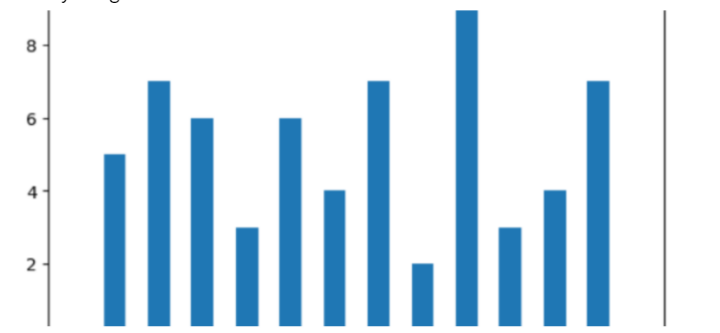
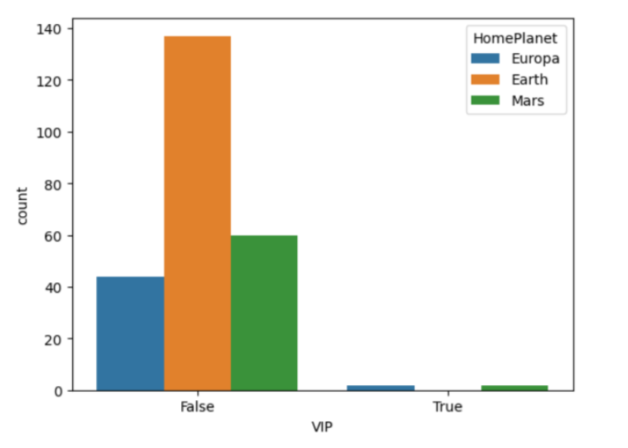
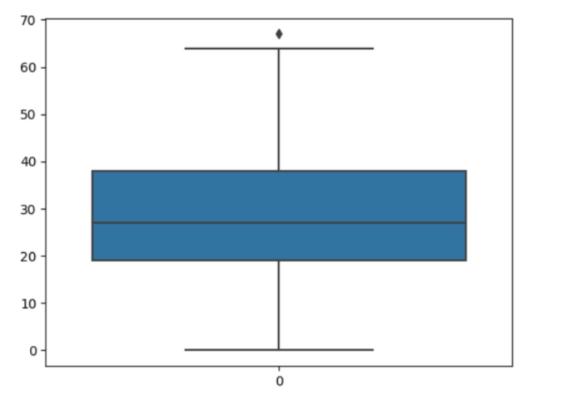
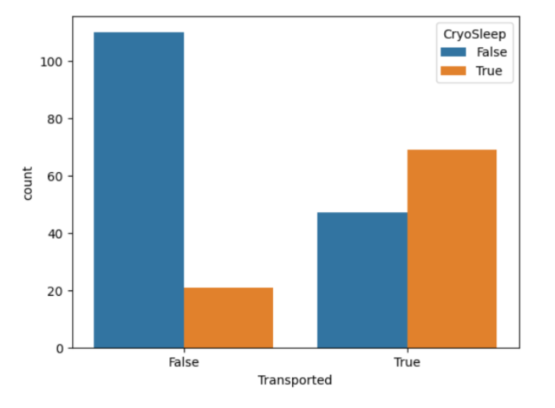
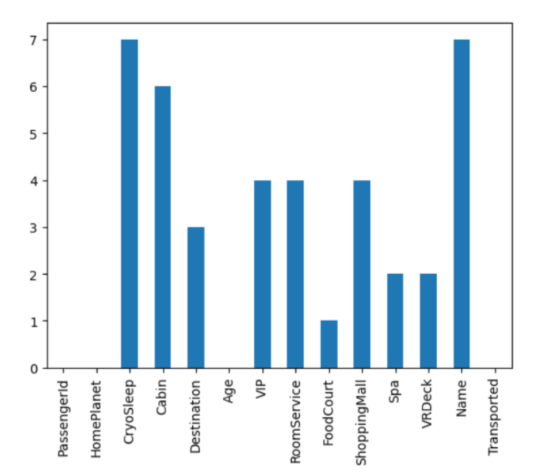
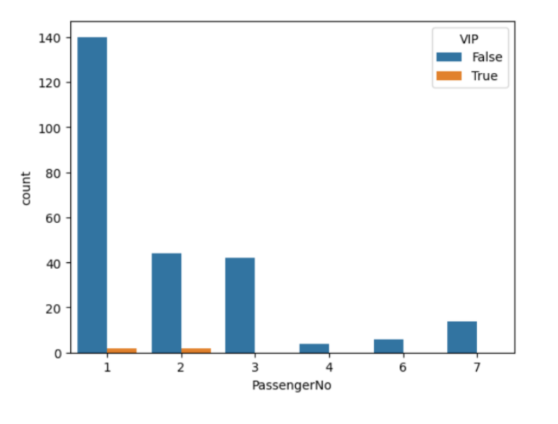
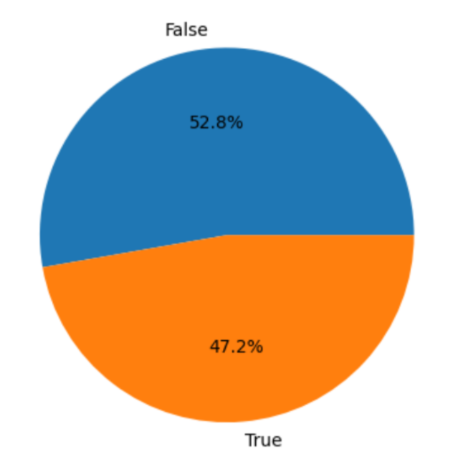
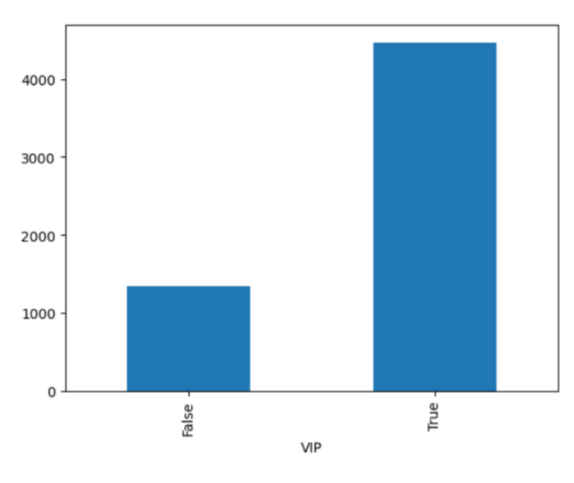
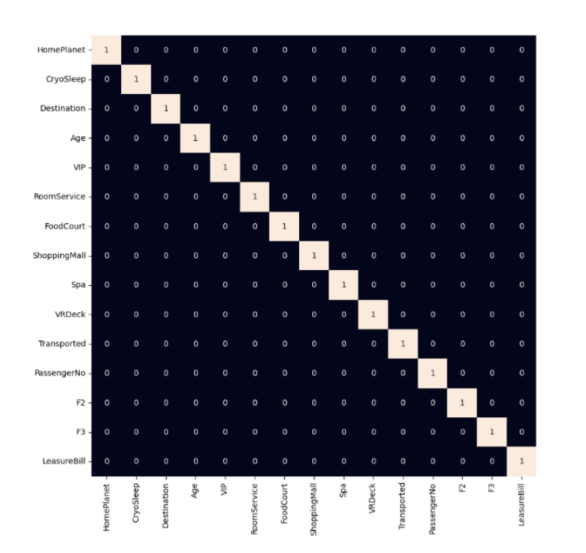
LogisticRegression() ?
Training Accuracy : 0.8922982036851439 Validation Accuracy : 0.8060606060606061
XGBClassifier() ?
Training Accuracy : 1.0 Validation Accuracy : 0.7454545454545454
SVC(probability=True) ?
Training Accuracy : 0.9266825996453628 Validation Accuracy : 0.7878787878787878
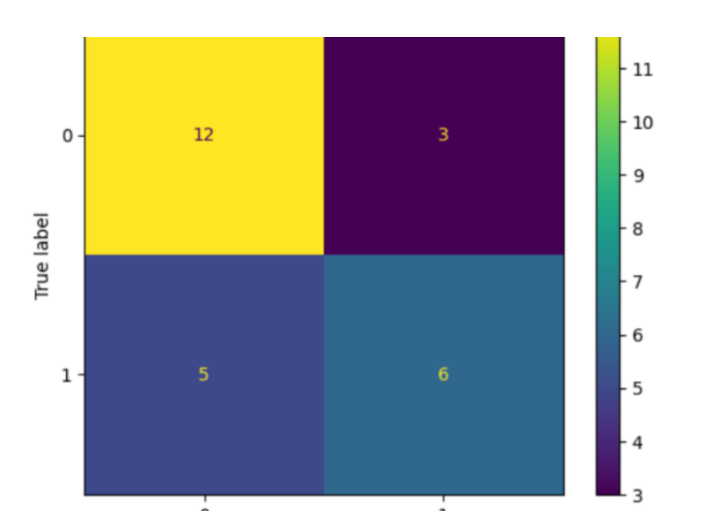
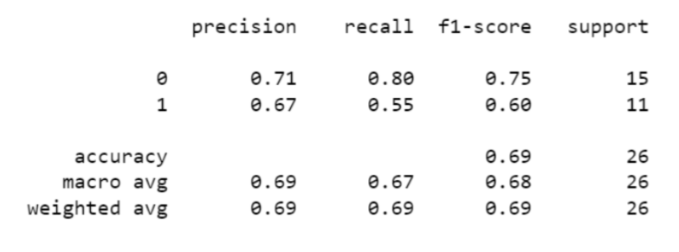
Using the performance matrix, you can conclude that the model is easily able to predict positive values as positive but the same is not true for the negative values.
Conclusion
For doing this Spaceship Titanic project, you can also use other models like K-nearest neighbors (KNN), Support Vector machine (SVM), Random Forest (RF) and Naive Bayes etc. Also, here we preprocessed the data on our own. However, you can do it with other datasets available on the internet which are already preprocessed. This will save us a number of steps and make our task easier.

